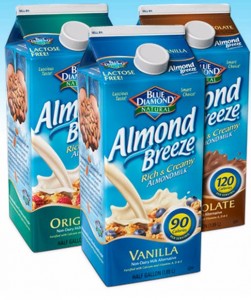 Being in a frumpy mood one day, when I walked into a grocery store I asked, “Where can I find your drupe milks?”
Being in a frumpy mood one day, when I walked into a grocery store I asked, “Where can I find your drupe milks?”
A puzzled clerk pondered the statement, running through a list of products and aisle numbers in her head, exclaimed, “Aisle four, second shelf.” A good guess I presumed and I wandered to the aisle and found the shelves stacked with soy milk (a legume by the way).
She wasn’t far off. Below the soy sat almond milk and several other milks considered nuts yet are in actuality drupes.
So what is a drupe? It is a fruit that has an outer fleshy part surrounding a shell that contains a seed. A peach is a drupe where the fruit is eaten and the seed discarded. Then there are other fruits such as almonds where the fleshy fruit is discarded and the seed is eaten. The seeds are considered nuts because of their fleshy texture and high fat content. These nuts are highly nutritious containing vitamins and minerals.
Some common drupes besides almonds are walnuts, brazil nuts, pecans and coconuts. So why drink these nut milks? For those who are lactose intolerant, the nut milks offer a great alternative to dairy milk.
But let me take it one step further. Alas, most anything that is packaged and sent to market is pasteurized and/or highly processed. The nutritional value is nominal, nominal enough that you will notice vitamins and minerals are screaming headlines on their packaging, “Now with more calcium!” The more calcium added is in the form of tricalcium phosphate. I say, keep to what mother nature prepared.
So my advice: simply make your own milk. It’s easy, nutritious and tastes better than store bought. My favorite nut (drupe) milks – almonds and Brazil – provide many good things for the body.
Almonds for one contain a high level of calcium, magnesium and potassium, all great for bones and hearth health. Along with fiber, folic acid, and riboflavin, they contain more antioxidants and vitamin E than any other nut and that’s great for balancing cholesterol levels. They also contain oleic and linoleic acid (omega-6), both fats with powerful antioxidant qualities.
Just a few Brazil nuts a day provide the recommended daily amount of selenium which is vital to immune system function and helps prevent free radical damage in the body. Brazil nuts also contain omega-3 fatty acids. Since they contain a lot of monounsaturated and polyunsaturated fats (25%), it’s best to consume Brazil nuts in small quantities.
And on top of it all, nuts contain protein and when their milk is prepared at home, the proteins are easier to digest.
The key to making any nut milk at home is to soak them from a raw state (not roasted or toasted or barbequed). For almonds, soak 8-12 hours. For Brazil nuts soak 2 hours. Soaking removes an enzyme inhibitor thereby making it much more digestible.
For the nut milks you’ll need: 4 cups of filtered water, 1 cup raw soaked and drained almonds or Brazil nuts (organic is always best), 5-6 pitted dates (or two tablespoons maple syrup) and 1 tablespoon vanilla extract (or better yet 1 vanilla bean pod scraped out with a spoon).
Blend 2 cups of water and ½ cup of almonds or Brazil nuts in a blender for 1-1/2 minutes. Then add remaining 2 cups of water, ½ cup of almonds or Brazil nuts, dates or maple syrup and vanilla. You can add a teaspoon of cinnamon, a teaspoon of ground nutmeg, and a ¼ teaspoon of ground cloves for added flavor.
Mix all of the remaining ingredients for approximately 1 minute. Then strain through a fine wire mesh, cheese cloth or nut-milk bag. Be sure to store in a glass container in the refrigerator.
Drink it straight up or have it nice and warm in a latte. Or add it to a yummy good-morning smoothie. It’s all good.




